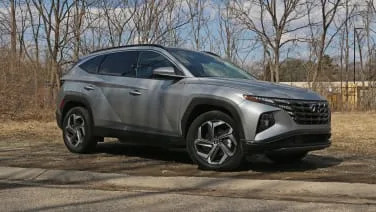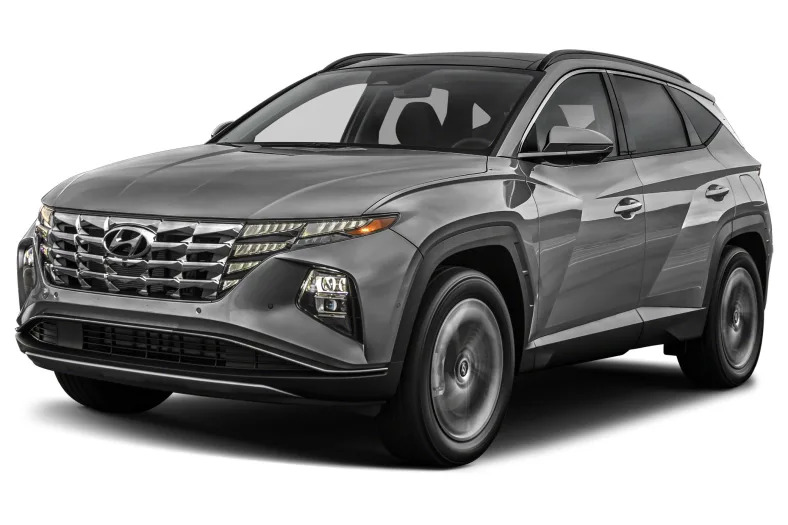Limited 4dr All-Wheel Drive
2022 Hyundai Tucson Plug-In Hybrid
Industry
This is not our first “First Drive” of the 2022 Hyundai Tucson, but it is our first time behind the wheel of the plug-in hybrid version, which arrived a little later than the naturally aspirated 2.5-liter and hybrid 1.6-liter turbo models, both of which we’ve driven extensively. Our verdict there was pretty firm: If you want a new Tucson, the hybrid is the one to buy as the 2.5-liter gas-only four-cylinder is quite underwhelming. (Learn the difference between hybrids and plug-in hybrids here). But if the hybrid is potent at 226 horsepower, the plug-in is downright punchy at 261 thanks to its larger electric motor (90 hp in the PHEV vs. 59 hp in the HEV). Both hybrids make 258 pound-feet of total system torque. An output of 261 horses would normally be more than enough for a compact crossover like the Tucson, but since it’s a PHEV, that power comes with a penalty that must be made up for. The bigger motor and substantially larger 13.8 kWh battery pack combine for a hefty 366 extra pounds when comparing a hybrid SEL to the PHEV (3,715 vs. 4,081 lbs). Spring for a Limited like our test model and you’re looking at a 4,235-pound curb weight. That brings us to the proverbial elephant in the room: the Toyota RAV4 Prime plug-in hybrid. Not only does Il Primo pack 302 horsepower, but it weighs roughly the same as the Tucson (4,235 for its SE trim, 4,300 for the XSE). It also offers nearly 30% more electric-only range (42 miles to the Tucson’s 33) and better all-around fuel economy (36 mpg combined to the Tucson’s 35, though that’s a negligible difference). This for two cars which, on paper at least, are virtually the same exact size. On the road, our Limited tester felt every bit of its hefty curb weight. While 261 horsepower is more than adequate for day-to-day, it’s not going to wow your friends during a ride-along the way some more potent PHEVs will. The instant torque from the electric motor helps off the line, but that does no good when it comes time to turn or stop. The Tucson PHEV also lacks the sharper (note that we didn’t say “sharp”) suspension tuning of the Prime, which is exclusively offered in the RAV4’s sporty SE and XSE trim levels. Both Tucson hybrid variants were engineered with a system that loops in some electric regen for a mildly enhanced take on brake-based torque vectoring, but it won’t make the Tucson corner any flatter or brake any quicker. Fortunately, the PHEV takes after the standard HEV, which means it’s far more pleasant to drive than models equipped with the 2.5-liter base engine. The available drive modes work as expected, with “Sport” prioritizing off-the-line grunt and quick passing power. Having a conventional six-speed automatic rather than the CVTs typically found in hybrids helps the PHEV feel like a normal car that just happens to be blessed with additional grunt. Only when put in EV …
Full Review
This is not our first “First Drive” of the 2022 Hyundai Tucson, but it is our first time behind the wheel of the plug-in hybrid version, which arrived a little later than the naturally aspirated 2.5-liter and hybrid 1.6-liter turbo models, both of which we’ve driven extensively. Our verdict there was pretty firm: If you want a new Tucson, the hybrid is the one to buy as the 2.5-liter gas-only four-cylinder is quite underwhelming. (Learn the difference between hybrids and plug-in hybrids here). But if the hybrid is potent at 226 horsepower, the plug-in is downright punchy at 261 thanks to its larger electric motor (90 hp in the PHEV vs. 59 hp in the HEV). Both hybrids make 258 pound-feet of total system torque. An output of 261 horses would normally be more than enough for a compact crossover like the Tucson, but since it’s a PHEV, that power comes with a penalty that must be made up for. The bigger motor and substantially larger 13.8 kWh battery pack combine for a hefty 366 extra pounds when comparing a hybrid SEL to the PHEV (3,715 vs. 4,081 lbs). Spring for a Limited like our test model and you’re looking at a 4,235-pound curb weight. That brings us to the proverbial elephant in the room: the Toyota RAV4 Prime plug-in hybrid. Not only does Il Primo pack 302 horsepower, but it weighs roughly the same as the Tucson (4,235 for its SE trim, 4,300 for the XSE). It also offers nearly 30% more electric-only range (42 miles to the Tucson’s 33) and better all-around fuel economy (36 mpg combined to the Tucson’s 35, though that’s a negligible difference). This for two cars which, on paper at least, are virtually the same exact size. On the road, our Limited tester felt every bit of its hefty curb weight. While 261 horsepower is more than adequate for day-to-day, it’s not going to wow your friends during a ride-along the way some more potent PHEVs will. The instant torque from the electric motor helps off the line, but that does no good when it comes time to turn or stop. The Tucson PHEV also lacks the sharper (note that we didn’t say “sharp”) suspension tuning of the Prime, which is exclusively offered in the RAV4’s sporty SE and XSE trim levels. Both Tucson hybrid variants were engineered with a system that loops in some electric regen for a mildly enhanced take on brake-based torque vectoring, but it won’t make the Tucson corner any flatter or brake any quicker. Fortunately, the PHEV takes after the standard HEV, which means it’s far more pleasant to drive than models equipped with the 2.5-liter base engine. The available drive modes work as expected, with “Sport” prioritizing off-the-line grunt and quick passing power. Having a conventional six-speed automatic rather than the CVTs typically found in hybrids helps the PHEV feel like a normal car that just happens to be blessed with additional grunt. Only when put in EV …
Hide Full Review
Hide Full Review
Retail Price
$43,200
MSRP / Window Sticker Price
| Engine | I-4 |
| MPG | 35 Combined |
| Seating | 5 Passengers |
| Transmission | 6-spd auto w/OD |
| Power | 180 @ 5500 rpm |
| Drivetrain | HTRAC all wheel |
Smart Buy Program is powered by 

Latest Tucson Plug-In Hybrid News
-
 2022 Hyundai Tucson PHEV First Drive Review | Plug-in without the premium
2022 Hyundai Tucson PHEV First Drive Review | Plug-in without the premium
-
 2022 Hyundai Tucson PHEV starts at $35,975
2022 Hyundai Tucson PHEV starts at $35,975

